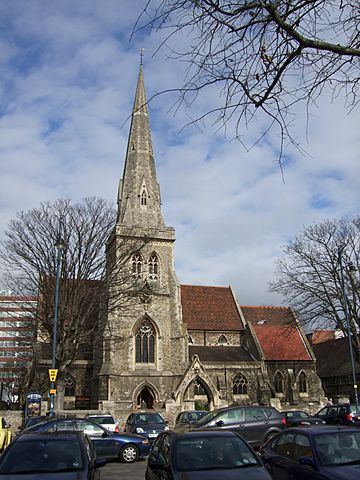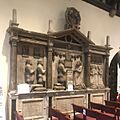Church of St Edward the Confessor, Romford facts for kids
Quick facts for kids St Edward's Church |
|
|---|---|

St Edward the Confessor, Market Place, Romford
|
|
| Location | Romford, London Borough of Havering |
| Country | England |
| Denomination | Church of England |
| Churchmanship | Anglo-Catholic |
| History | |
| Dedication | Blessed Virgin Mary and St Edward the Confessor |
| Architecture | |
| Architect(s) | John Johnson |
| Style | Victorian Gothic |
| Administration | |
| Parish | Romford |
| Deanery | Havering |
| Archdeaconry | Barking |
| Diocese | Chelmsford |
| Province | Canterbury |
The Church of St Edward the Confessor is an Anglican church located in Romford, London Borough of Havering, England. It's also known as the Parish Church of the Blessed Virgin Mary and St Edward the Confessor. This church is part of the Diocese of Chelmsford. The building you see today was built between 1849 and 1850. It replaced an older church that was taken down in the mid-1800s. People have worshipped on this spot since the late 1300s! The current church was designed in a Gothic style by a famous English architect named John Johnson. In 1952, it was given a special Grade II* listed building status by English Heritage, meaning it's a very important historical building.
Contents
History of St Edward's Church
Early Churches in Romford
Romford's first known place of worship was a small chapel. It was built in 1177 and was named after Saint Andrew. This chapel was located near the River Rom. It was used until the late 1300s, when it fell apart and was eventually taken down. The area known as Oldchurch, including Oldchurch Park, gets its name from this very old chapel.
The Church of 1410
A new church was built on the same spot where the current church stands today. It was finished in 1410. A bishop named Henry Chichele officially blessed the church grounds on March 23, 1410. It was dedicated to the Virgin Mary and St Edward the Confessor.
This church had a chancel (the area around the altar) and a nave (the main part where people sit). It also had a longer and wider north aisle. The church featured a brick tower with five bells. Later, a gallery was added inside the church. A charity for orphaned children was started there.
By 1710, this orphanage became St Edward's School. It moved to a different building in Romford's Market Place in 1728. About 30 years later, a new clock was put in, and three more bells were added to the church's peal. This church was used until 1844. That's when work began on a new church nearby.
The new building was designed by Edward Blore. It was meant to be a small chapel. However, halfway through building it, the planners decided to move the town's main church back to Market Place. The last services were held at the old church in Market Place in 1849, and then it was taken down. Blore's chapel remained and was used as a burial ground. It was eventually taken down in 1953.
The Current Church Building
The church building you see in Market Place today was designed by the English architect John Johnson. He also designed the famous Alexandra Palace in London in 1874. The builder for the church was John Kelk, who often worked with Johnson.
The first stone of the new church was laid on July 14, 1849. A politician named Thomas William Bramston did the honors. The church was officially blessed on September 19, 1850, by George Murray, the Bishop of Rochester. Building the church cost about £8,000. Money came from loans, a gift from New College, Oxford, and donations from people.
Johnson designed the church in the Gothic style of the 1300s. It was built using Kentish Ragstone and Bath stone. Some materials even came from John Nash's Quadrant in Regent Street, London, which was being taken down at the time. This might explain the many carved faces you can see, like kings, queens, bishops, and other interesting figures.
The beautiful stained glass window on the east side of the church was made by Charles Edmund Clutterbuck. The three windows in the south chapel were made by William Wailes. The wall separating the churchyard from the Market Place might be as old as the second church from the 1300s.
The church had some small damage during the Second World War. During repairs in 1944, an electric clock and chime bells were put in. This might have replaced bells that were taken for the war effort. On July 4, 1952, the church was officially recognized as a Grade II* listed building.
By 1965, the St Edward's School had moved to a new spot and became a secondary school. A new organ was installed in the church in 1979. Five years later, the Church House was repaired. A big renovation happened in 1988. This included putting in under-floor heating and changing the fixed pews to movable ones.
In 2001, the church received a grant. This allowed them to add a lavatory and kitchen facilities. In the same year, a special wooden carving of St Edward the Confessor was made and placed in the main entrance. The next year, chairs replaced the movable pews. The church's tall spire, which is 162 feet high, had major repair work done in 1992.
Inside the Church
The church's inside has a main area called the nave with five sections. It also has a clerestory, which is a high section with windows. There are north and south aisles, a chancel (the area near the altar), and a Lady Chapel. A west gallery is also present. Two vestries (rooms for clergy) were added in 1885.
On the south wall of the chancel, there is a monument for George Hervey. On the north wall, you can find a memorial for Anthony Cooke. This memorial is thought to be made by the sculptor Cornelius Cure or his father, William. The church also displays a silver communion plate. It was given by a church member and made by the jeweler John Turner.
Images for kids
-
Memorial dedicated to Sir Anthony Cooke who died 1576


